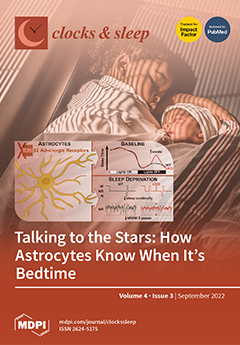Open AccessReview
The Effect of Light Therapy on Electroencephalographic Sleep in Sleep and Circadian Rhythm Disorders: A Scoping Review
by
Teha B. Pun, Craig L. Phillips, Nathaniel S. Marshall, Maria Comas, Camilla M. Hoyos, Angela L. D’Rozario, Delwyn J. Bartlett, Wendy Davis, Wenye Hu, Sharon L. Naismith, Sean Cain, Svetlana Postnova, Ron R. Grunstein and Christopher J. Gordon
Cited by 2 | Viewed by 4028
Abstract
Light therapy is used to treat sleep and circadian rhythm disorders, yet there are limited studies on whether light therapy impacts electroencephalographic (EEG) activity during sleep. Therefore, we aimed to provide an overview of research studies that examined the effects of light therapy
[...] Read more.
Light therapy is used to treat sleep and circadian rhythm disorders, yet there are limited studies on whether light therapy impacts electroencephalographic (EEG) activity during sleep. Therefore, we aimed to provide an overview of research studies that examined the effects of light therapy on sleep macro- and micro-architecture in populations with sleep and circadian rhythm disorders. We searched for randomized controlled trials that used light therapy and included EEG sleep measures using MEDLINE, PubMed, CINAHL, PsycINFO and Cochrane Central Register of Controlled Trials databases. Five articles met the inclusion criteria of patients with either insomnia or delayed sleep–wake phase disorder (DSWPD). These trials reported sleep macro-architecture outcomes using EEG or polysomnography. Three insomnia trials showed no effect of the timing or intensity of light therapy on total sleep time, wake after sleep onset, sleep efficiency and sleep stage duration compared to controls. Only one insomnia trial reported significantly higher sleep efficiency after evening light therapy (>4000 lx between 21:00–23:00 h) compared with afternoon light therapy (>4000 lx between 15:00–17:00 h). In the only DSWPD trial, six multiple sleep latency tests were conducted across the day (09:00 and 19:00 h) and bright light (2500 lx) significantly lengthened sleep latency in the morning (09:00 and 11:00 h) compared to control light (300 lx). None of the five trials reported any sleep micro-architecture measures. Overall, there was limited research about the effect of light therapy on EEG sleep measures, and studies were confined to patients with insomnia and DSWPD only. More research is needed to better understand whether lighting interventions in clinical populations affect sleep macro- and micro-architecture and objective sleep timing and quality.
Full article
►▼
Show Figures






